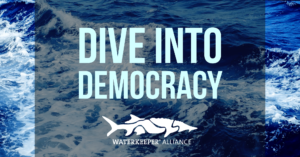
A few weeks ago we warned about the threats of “emerging contaminants” to water quality and drinking water. This week, we are focusing on one class of emerging contaminants—PFAS.
Per- and polyfluoroalkyl substances (PFAS) may be in the drinking water of more than a hundred million people in the U.S, and no region of the United States is immune from this serious and growing threat. These man-made chemicals are used to manufacture items such as non-stick cookware, stain-resistant clothes, and firefighting foam, and are released into the ground and waterways at manufacturing plants and military bases around the country. PFAS can have serious health impacts even at very low levels. The threat to human health is compounded by the fact that traditional drinking water treatment systems are not able to remove PFAS from drinking water.
Please sign our petition calling for urgent action to protect our drinking water!
Even though companies began manufacturing PFAS over 50 years ago, the U.S. Environmental Protection Agency (EPA) is just beginning to study and respond to the threat that this widespread pollution poses to human health. This is in part because companies such as 3M and DuPont deliberately hid research showing the health risks from their employees and the federal government. But it is also due to the slow process by which “emerging contaminants” are regulated by EPA.
The residents of Wilmington, N.C. found out the hard way how deception, regulatory loopholes, and delays can have devastating effects. The Chemours Company had been discharging the chemical GenX, a type of PFAS, into the Cape Fear River for nearly forty years, and knew about potential health impacts; residents only found out about this serious threat after the chemical was detected in their drinking water. Chemours recently agreed to a consent order requiring the company to clean up its pollution and provide clean drinking water to impacted residents. But this resolution came from a lawsuit brought by the state and Cape Fear River Watch, parent organization of Cape Fear Riverkeeper—not from EPA action.
Despite the serious threat to human health and a large number of people at risk of exposure, the Trump administration has recently tried to suppress a study by the U.S. Agency for Toxic Substances and Disease Registry on PFAS out of public relations fears. However, under immense public pressure, EPA is finally starting to take action to address the widespread threat of PFAS in our water. Recently, EPA released the first assessment of the toxicity of GenX, showing it may be nearly as toxic as other types of PFAS.
These steps are important, but much of it is 50 years too late. We need urgent action and an overhaul of how we protect human health and the environment to prevent another slow-motion poisoning of our nation’s waterways and drinking water.
Sign our drinking water petition today!
 Dive Into Democracy is Waterkeeper Alliance’s weekly roundup of current attacks on America’s clean water protections and how to take action. Want to get them in your email? Sign up here.
Dive Into Democracy is Waterkeeper Alliance’s weekly roundup of current attacks on America’s clean water protections and how to take action. Want to get them in your email? Sign up here.